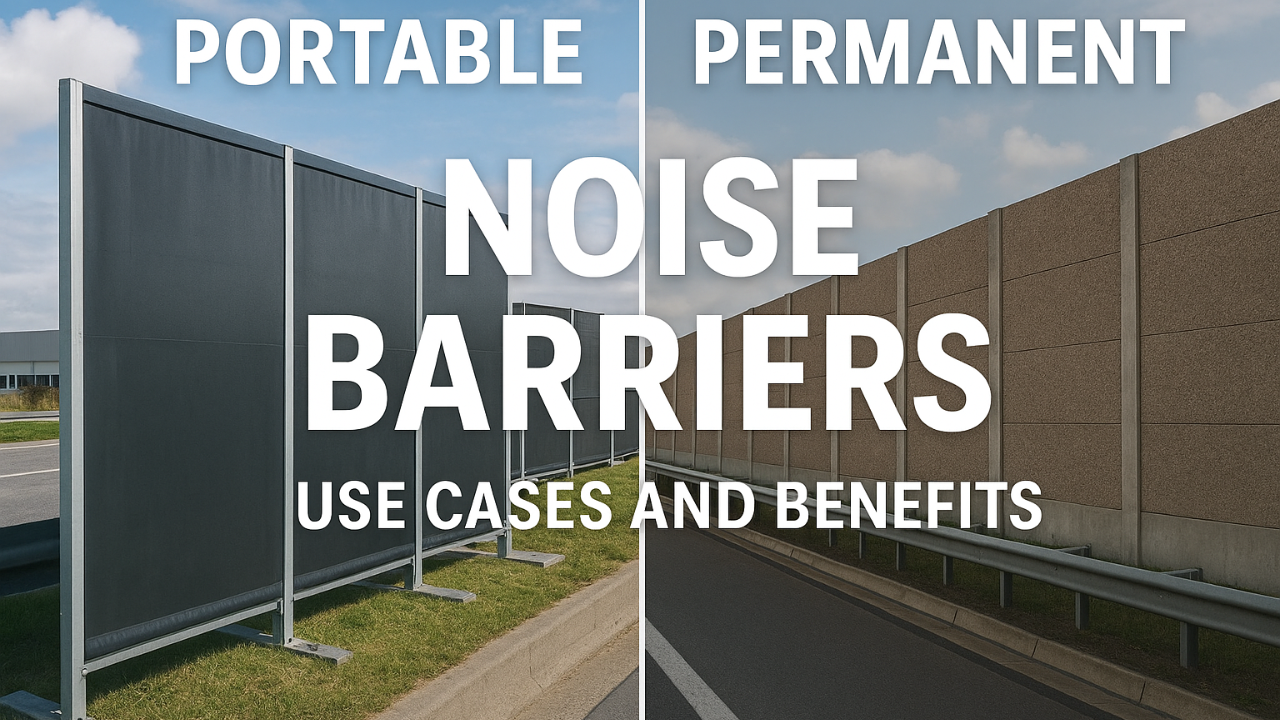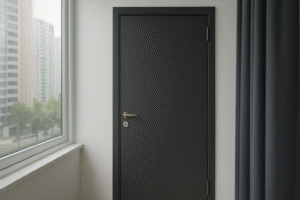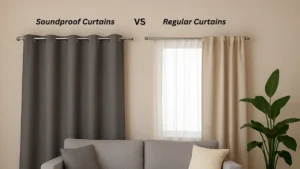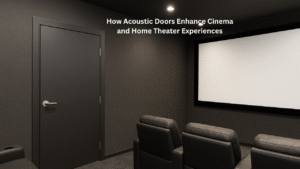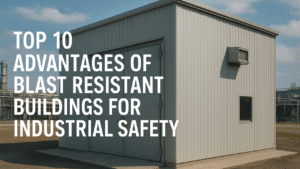Choosing the Right Noise Barrier: Comparing Portable and Permanent Solutions for Effective Sound Control
Noise pollution has become one of the most pressing issues in modern industrial, commercial, and urban environments. From construction activities and road traffic to factories and machinery, unwanted noise continues to harm health, productivity, and overall quality of life, making the use of an effective Noise Barrier essential for controlling and reducing these sound disturbances.
As industries and cities expand, effective noise control solutions have become a necessity, not just for comfort but for legal and environmental compliance. One of the most reliable and efficient tools for managing unwanted sound is the noise barrier, a structure designed to block, absorb, or redirect sound waves.
Among noise control systems, two main types are widely used: portable noise barriers and permanent noise barriers. While both serve the same purpose, reducing noise transmission, their design, application, and performance vary significantly, especially when implementing a Noise Barrier on Highway projects where long-term sound control is essential.
This article provides an in-depth explanation of the differences, use cases, and benefits of portable and permanent noise barriers, helping you select the most suitable option for your project or facility.
Portable Noise Barriers: Design, Function, and Features
Portable noise barriers, including Highway Noise Barrier systems, are lightweight, modular, and movable structures used for short-term noise reduction. They are ideal for dynamic work environments such as construction sites, maintenance projects, or temporary events, where flexibility and quick installation are essential.
1. Construction and Materials
Portable noise barriers are made from multi-layer acoustic panels designed to absorb and block noise effectively. They typically include:
- Acoustic cores made from materials like mineral wool or polyurethane foam
- Reinforced outer layers, such as PVC-coated fabric, for weather resistance
- Reflective backing panels that redirect sound away from sensitive areas
These barriers are lightweight yet durable, allowing easy relocation while maintaining strong acoustic performance.
2. Installation and Mobility
Portable noise barriers are built for fast and easy installation. Most designs feature hook-and-loop systems, zippers, or modular connections that allow workers to set them up quickly without specialized tools.
They can be hung on temporary fences, scaffolds, or freestanding frames, making them suitable for projects that move frequently or require flexible layout adjustments.
3. Acoustic Performance
High-quality portable barriers can achieve noise reduction levels of 20–35 dB(A), depending on the barrier’s thickness, material quality, and configuration. They help construction and industrial teams comply with local noise control regulations while maintaining productivity.
4. Durability and Maintenance
These barriers are typically UV-resistant, waterproof, and fire-retardant, ensuring reliable performance outdoors. Maintenance is minimal, usually limited to regular cleaning and inspection for tears or wear.
Permanent Noise Barriers: Design, Function, and Features
Permanent noise barriers are fixed, engineered structures designed for continuous noise control over long durations. They are used in industrial plants, highways, airports, and residential protection zones.
1. Construction and Materials
Permanent barriers are built using concrete, metal, brick, or composite materials combined with sound-absorbing cores.
Their structure is optimized to deliver maximum sound attenuation while maintaining stability and aesthetics. Many modern installations integrate architectural finishes or greenery for visual appeal.
2. Installation Process
Permanent barriers require foundation work and structural engineering. Site assessments consider soil type, wind load, and sound propagation before installation. The process takes longer than portable systems but ensures higher durability and long-term efficiency.
3. Acoustic Performance
Permanent noise barriers can achieve noise reductions exceeding 40 dB(A) when properly engineered. They are ideal for environments with constant or high-intensity sound sources such as highways, factories, and power plants.
4. Lifespan and Maintenance
Designed for long-term use, permanent barriers typically last 20 to 50 years or more. They require little maintenance beyond periodic inspections for cracks or corrosion, offering long-term reliability and value.
Key Differences Between Portable and Permanent Noise Barriers
| Aspect | Portable Noise Barriers | Permanent Noise Barriers |
| Purpose | Temporary or short-term noise control | Long-term or continuous noise control |
| Mobility | Easily movable and reusable | Fixed in place |
| Installation Time | Quick setup, minimal tools | Requires groundwork and engineering |
| Material | Fabric and composite panels | Concrete, steel, or masonry |
| Durability | Moderate (3–10 years) | High (20–50 years) |
| Noise Reduction | Up to 35 dB(A) | Up to 45 dB(A) |
| Cost | Lower initial cost | Higher upfront cost, long-term savings |
| Maintenance | Simple and frequent | Minimal once installed |
| Applications | Construction, events, temporary sites | Highways, industrial zones, and factories |
Use Cases of Portable Noise Barriers
Portable barriers are ideal for projects requiring flexibility and mobility. Their quick setup and reusability make them valuable across multiple industries.
1. Construction and Demolition Sites
Construction noise from machinery, drilling, and heavy equipment can exceed permissible limits. Portable barriers, or in some cases a Concrete Noise Barrier for more demanding environments, help reduce this noise impact, keeping nearby residents and workers safe from excessive exposure. As projects progress, the barriers can be relocated to active zones, maintaining effective coverage throughout different stages of construction.
2. Road and Infrastructure Maintenance
Short-term road repairs and urban maintenance projects benefit greatly from portable barriers. These panels minimize sound exposure to nearby communities while ensuring work continues smoothly and safely.
3. Outdoor Events and Entertainment
Concerts, sports events, and festivals generate high noise levels that can disturb surrounding areas. Portable acoustic barriers contain sound within event spaces, ensuring compliance with local regulations and enhancing attendee experience.
4. Temporary Industrial Operations
During equipment testing, maintenance, or expansion phases, factories can generate unusual noise levels. Portable barriers offer a practical, temporary solution without the need for permanent construction.
5. Emergency and Defense Applications
In field operations or emergency setups, portable barriers help manage generator or machinery noise quickly and efficiently. Their mobility makes them suitable for military, disaster-relief, and remote site operations.
Use Cases of Permanent Noise Barriers
Permanent noise barriers are essential for locations that need consistent and reliable sound control for years or decades.
1. Highways and Railways
Permanent barriers are widely used along roads and railways to reduce traffic noise that affects nearby residential or commercial areas. Their design focuses on durability, wind resistance, and sound deflection efficiency.
2. Industrial and Manufacturing Facilities
Industrial operations often produce high-decibel noise from machinery like compressors, pumps, and turbines. Permanent barriers isolate these sources, ensuring compliance with safety regulations and improving working conditions.
3. Power Plants and Energy Stations
Power generation facilities operate continuously, producing steady noise levels from turbines and generators. Permanent barriers provide ongoing protection for both employees and surrounding communities.
4. Residential and Urban Developments
In urban planning, permanent barriers protect housing complexes and community zones located near highways or factories. They are often designed with aesthetic elements such as plants or architectural finishes to complement the environment.
5. Airports and Transportation Hubs
Airports and metro depots use permanent barriers to mitigate noise from aircraft and operational equipment. Properly engineered installations significantly lower the impact of takeoff, landing, and taxiing sounds.
Benefits of Portable Noise Barriers
1. Quick Setup
Portable barriers can be installed and repositioned within hours, making them ideal for time-sensitive projects or changing work zones.
2. Flexibility
They can be adapted to various layouts, allowing for customized sound control in confined or irregular spaces.
3. Cost Efficiency
Portable barriers require no permanent foundation, making them more affordable for short-term applications. They also eliminate demolition costs when projects end.
4. Reusability
These barriers can be transported and reused across multiple sites, maximizing return on investment for construction firms or contractors.
5. Environmental Compliance
Portable systems help organizations meet temporary noise limits without breaching local or national sound regulations.
Benefits of Permanent Noise Barriers
1. High Noise Reduction
Permanent barriers provide superior noise attenuation, often exceeding 40 dB(A), suitable for heavy industrial or transportation applications.
2. Long-Term Value
Though installation costs are higher, their durability and minimal maintenance make them cost-effective over the decades.
3. Enhanced Safety
Built with strong materials and structural reinforcement, these barriers withstand harsh weather, wind loads, and impact without losing effectiveness.
4. Aesthetic and Functional Integration
Permanent installations can blend into the environment through design enhancements such as acoustic cladding, greenery, or customized finishes.
5. Compliance and Sustainability
They help companies maintain long-term compliance with ISO, OSHA, and environmental regulations, improving both public relations and corporate responsibility.
Choosing the Right Type of Noise Barrier
Selecting between portable and permanent noise barriers depends on several factors related to your project scope, budget, and duration.
1. Project Duration
- Short-term or temporary work → Portable barriers
- Long-term or continuous operations → Permanent barriers
2. Noise Intensity
Portable barriers suit moderate or intermittent noise sources, while permanent barriers handle high-decibel, continuous operations more effectively.
3. Site Flexibility
If your worksite shifts locations or has multiple zones, choose portable barriers.
If your site is fixed (like a plant or highway), permanent barriers are more suitable.
4. Budget
Portable barriers offer lower upfront costs, while permanent barriers provide better lifetime value due to long service life and low maintenance.
5. Regulatory Needs
Industrial facilities and transport infrastructure often face stricter regulations, requiring permanent noise barriers to maintain compliance with noise limits and zoning laws.
Ecotone Systems: Expert Providers of Noise Barrier Solutions
Ecotone Systems specializes in providing high-quality noise control solutions, including portable noise barriers, permanent noise barriers, and Highway Noise Reduction Barriers. With years of experience in the industry, Ecotone Systems designs and installs customized acoustic barriers that meet regulatory standards, improve safety, and enhance environmental comfort. Their team ensures each project, whether for industrial sites, highways, or urban developments, receives a tailored approach, delivering effective noise reduction and long-lasting performance.
Conclusion
Both portable and permanent noise barriers play critical roles in managing noise pollution across various industries.
Portable barriers excel in mobility, flexibility, and cost-effectiveness, making them perfect for temporary projects such as construction, events, and maintenance operations.
Permanent barriers, however, offer long-lasting noise suppression, durability, and structural reliability, making them the preferred choice for industrial facilities, highways, and residential noise control.
Choosing between the two depends on your project duration, noise intensity, and long-term goals. Whether you prioritize flexibility or permanence, investing in the right noise control solution, such as a Highway Noise Reduction Barrier, ensures compliance, enhances safety, and contributes to a healthier, more sustainable environment.

